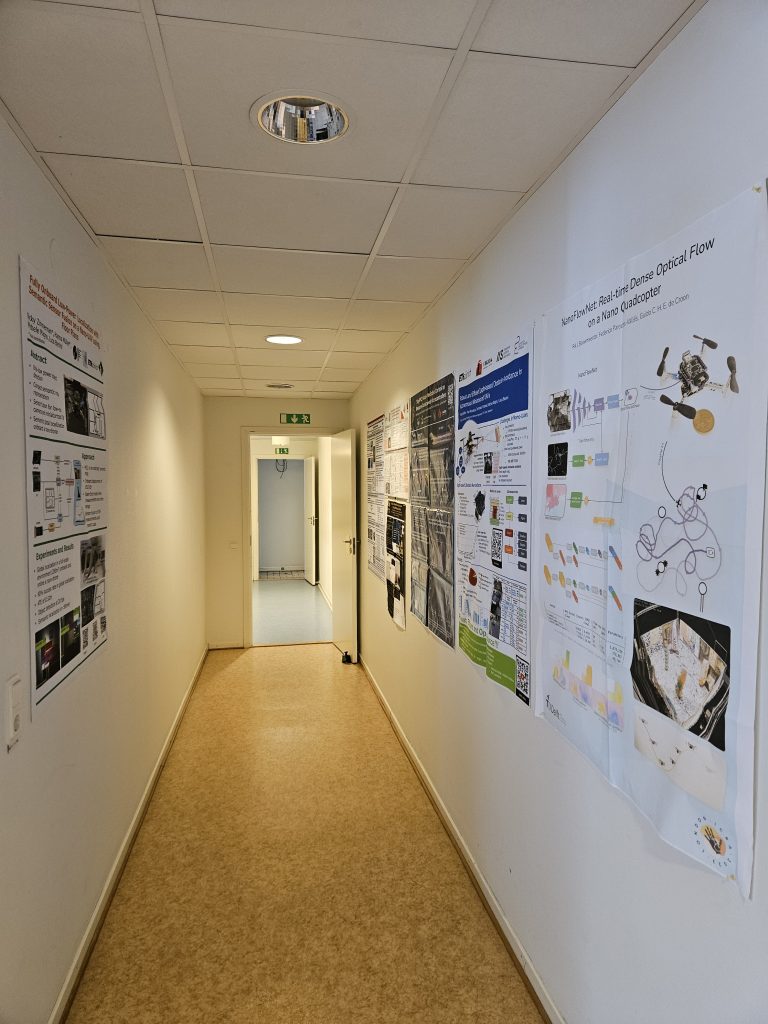As we mentioned earlier, ICRA Yokohama was full of exciting encounters – we really enjoyed meeting researchers, tech companies, and enthusiastic roboticists during those 4 days.
One challenge was to bring back as many research posters featuring the Crazyflies as possible. The goal was to decorate the walls of the office with them, as a “hall of fame”. And I’m really, really proud to show you how it turned up!


In total, we received 6 new posters. Here they are:
Optimal Collaborative Transportation for Under-Capacitated Vehicle Routing Problems using Aerial Drone swarms
Akash Kopparam Sreedhara, Deepesh Padala, Shashank Mahesh, Kai Cui, Mengguang Li, Heinz Koeppl
This paper presents a strategy for optimizing the collaborative transportation of payloads in an under-capacitated vehicle routing scenario. The Crazyflies work together to dynamically adjust routes based on real-time data and transport capacities, and collaborate to lift and transport heavier payloads.
From Shadows to Light: A Swarm Robotics Approach With Onboard Control for Seeking Dynamic Sources in Constrained Environments
T. A. Karagüzel, V. Retamal, N. Cambier and E. Ferrante
The paper describes a method for enabling a swarm of Crazyflies to dynamically seek and locate a moving target or source in constrained, GNSS-denied environments. Using a simple rule-based approach, the drones track dynamic source gradients and navigate obstacles autonomously with fully onboard systems.
CrazySim: A Software-in-the-Loop Simulator for the Crazyflie Nano Quadrotor
Christian Llanes, Zahi Kakish, Kyle Williams, and Samuel Coogan
We actually already have a blogpost presenting this paper, and we’re so happy to have it represented in our office now!
TinyMPC: Model-Predictive Control on Resource-Constrained Microcontrollers
Khai Nguyen, Sam Schoedel, Anoushka Alavilli, Brian Plancher, Zachary Manchester
The paper presents TinyMPC, a high-speed model-predictive control (MPC) solver designed for resource-constrained microcontrollers on small robots like the Crazyflie. TinyMPC efficiently handles real-time trajectory tracking and dynamic obstacle avoidance, outperforming traditional solvers.
Robust and Efficient Depth-Based Obstacle Avoidance for Autonomous Miniaturized UAVs
H. Müller, V. Niculescu, T. Polonelli, M. Magno and L. Benini
The paper introduces a lightweight obstacle avoidance system for nano quadcopters, leveraging a novel 64-pixel multizone time-of-flight (ToF) sensor to safely and effectively navigate complex indoor environments. Tested on the Crazyflie 2.1, the system achieves 100% reliability at a speed of 0.5 m/s, all while using only 0.3% of the onboard processing power, demonstrating its suitability for autonomous operations in unexplored settings.
Fully onboard Low-power localization with semantic sensor fusion on a Nano-UAV using floor plans
Nicky Zimmerman, Hanna Müller, Michele Magno, Luca Benini
This paper introduces a method for autonomous localization in nano-sized UAVs like the Crazyflie by fusing geometric data from time-of-flight sensors with semantic information extracted from images. The approach leverages annotated floor plans to improve navigation accuracy without adding extra deployment costs. The system operates efficiently with limited onboard computational resources, achieving a 90% success rate in real-world office environments.
A big thanks, once again, to all of those who gave us their posters!